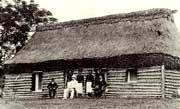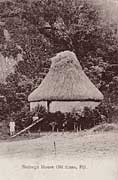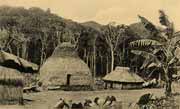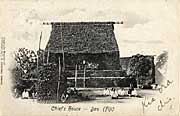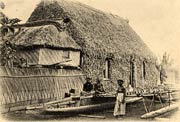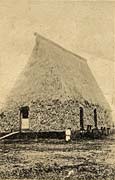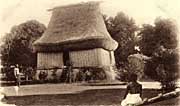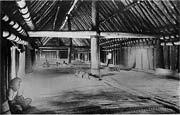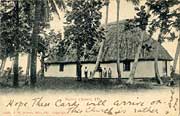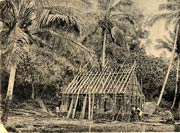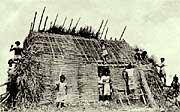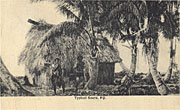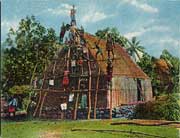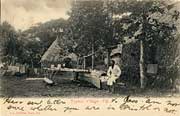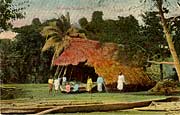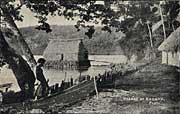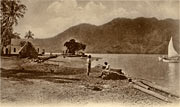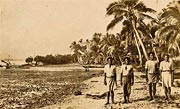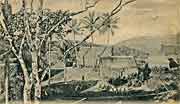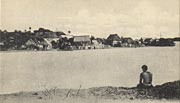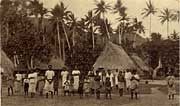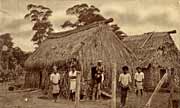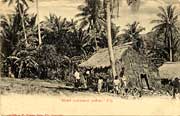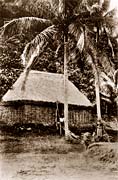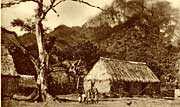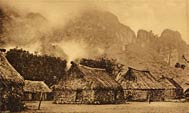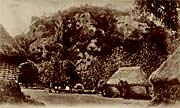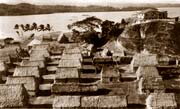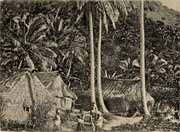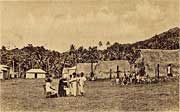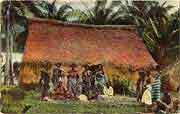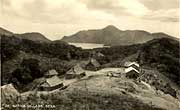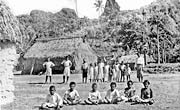|
Courthouse, RakiRaki, Ra, Vitilevu. 1908. (Original in the possession of Emily Ewins Wimmer, Auckland.) This first picture is actually not a postcard but a family photo from 1908, to put the foundation of this collection in context. The District Magistrate seated centre is my grandfather, William James Ewins, upon whose collection of postcards my collection was founded. See also DETAIL. He carries a fly whisk in his hand, Fijian badge of rank. Notable is the Fijian police officer behind him, wearing a red-brown smoked barkcloth headscarf denoting his high rank (particularly since he wears this in the magistrate's presence), and the two suited Indians on left and right, presumably court clerks. Their employment may have been a personal choice on his part. WJ had learned Hindi from his father, who spoke it well enough to have been offered a teaching position in the East India Company College in England. Where he learned it is unclear, whether in India or perhaps East Africa.. |
|
|
"Nadroga House Old Times, Fiji". Photographer/publisher: F.W.Caine. Original Collection: W.J. & R.M. Ewins. Addressed (but not sent) to "Mrs. Koch, Helensville, St James Park, Hawthorn, Melb" and signed "Rose" [my grandmother]. The Koch family were close relatives of my grandmother's, and the Tasmanian author Christopher Koch ("The Year of Living Dangerously") is a descendant of that family. This is a fine example of a style of house (were rausina) built exclusively in the Vitilevu Highlands (Colo). The floor plan is square rather than oblong, and instead of having two endposts and a ridgepole, a central post is used, the rafters radiating down to meet the top plate of the walls. Thus the roof is conical while the floorplan is rectangular. As far as I am aware this exact model is unique in the Pacific, though it may have its origins in the houses of New Caledonia. |
|
|
"Fijian Houses". Publisher: CoOperative No.175 Unused, undated. 1920s-early 1930s. From the terrain and the style of the central house (were rausina), this too was clearly taken in the Vitilevu Highlands (Colo).The second, smaller, house is rectangular in plan, in a style called there were väsemasema. The village is not identified on the card, but it appears to be the same one as in the postcard below. That is identified as "Koro Boi," but is actually Nakoroboya, which is (still) in the northern highlands toward Ra, northeast of Navosä where the house above was situated, very near to Vatukoula (the goldmine town, third largest town in Fiji). Though it is not so obvious in this photo as it is in general village photo, while the houses are (typically of Colo) more square than rectangular in floor plan, the roof shape in this part of Colo was more pyramidal than conical. |
|
|
"Chief's house - Bau (Fiji)". Publisher: L.N.Anderson, Levuka. Original Collection: Mrs Amy Wager, 1904. Addressed to "Mrs Amy Wager, 3 Hurlingham Villas, Ashley Hill, Bristol, England." Bears the inscription on the front: "Kia Ora Chris" From the tiered motte or housemound it would appear that this is not in fact a chief's house, but Na Vata ni Tawake, originally a famous temple (click HERE for a picture). This has been many times rebuilt (see the next frame for the successor to this), but by the 1930s a rather sad descendant of the original magnificent building was in place. This photo was clearly taken on the occasion of a significant ceremonial occasion, judging not only from the formal dress of the people but more particularly from the assembled presentation goods: a stack of yams (ibinibini ni uvi) in the left foreground; a large vuniyaqona - the stump of a pepper plant (kava - Piper methysticum) in the centre foreground; and just visible a woman with some pots next to that stump. |
|
|
"The Cannibal Temple, Bau (Fiji)". Publisher: Caine Series #22. Unused and undated, but probably pre-1920. This is the next incarnation of Na Vata ni Tawake, described in the previous frame. |
|
|
"Chief's house". Publisher: G.L.Griffiths, Suva, Fiji. This picture is also reproduced in the Cyclopedia of Fiji of 1907, and that together with the back of the card being undivided date it as around the turn of the 19th-20th Centuries. The Cyclopedia draws attention to the fact that there is a small sleeping house (valemoce) attached to the end of the main house, and also to the large ocean-going camakau outrigger canoe in the foreground. |
|
|
"Fijian chief's house". Publisher: Western Pacific Herald Series, Fiji. Unused and undated, but undivided back so no later than 1906. The tall roof on this chief's house was reasonably common at that time but is virtually never seen today. |
|
|
"A Chief's House, Fiji". Caine Series, Suva, Fiji. J.W.Waters Photo.#23. Unused postcard. Printed in England. "Real Photo Post Card. British made." About 1907, I have seen another print of it sent in that year. This is a fine example of a traditional chief'shouse, standing on a high stone yavu housemound. The main door in the centre of the long side is reached in this case by a set of ladder-style steps, though the strictly traditional model was a plank with footrungs, as shown in the Nadroga house above. The second door visible at the end of the building was for the family to come and go by, the main door reserved for guests. Today there are often three or four doors, but traditionally there were only these two. Traditional houses had no windows, and when these were introduced as a result of European influence, they were called "short doors" (katuba leka). For a scholarly analysis of the significance and symbolism of Fijian house layout, see Toren, Christina. 1990. Making sense of hirerarchy: cognition as social process in Fiji. London, Athlone Press. |
|
|
"Chief's house, Fiji" Publishers: Co Operative No.144. Unused and undated, but no later than 1920s. A larger building with a somewhat different form of thatch, this house is in its essentials similar to the previous one. These large houses were not necessarily the domestic dwelling of the chief, but were often maintained by him as meeting-houses, guest houses, and places where the young unmarried men of the village slept. |
|
|
"Chief's house, Fiji" Published by Arthur Mills, Suva, Fiji. Unused,undivided back pre-1906. Another large building similar to the previous one, but with a less lofty roof. The chief (seated) appears to be holding an audience on the green near his meeting-house. |
|
|
"Native house, Fiji" No publisher, numbered 10. Divided back.Unused and undated, perhaps around 1920. Another large building similar to the previous one. |
|
|
"Interior of Fijian guest house" Publisher Caines #24. Unused, undated. The interior of a large building similar to those previous. |
|
|
"Interior of Chief's Home, Fiji". Tuck's Post Card. Publisher Raphael Tuck & Sons Ltd., Art Publishers to Their Majesties the King and Queen".On the reverse has the caption: "One of the highest Chiefs in Fiji in his home constructed without the use of a nail. Wall covered with native cloth, floor with native mats." The title given by Tuck's to this photograph trivialises the significance of the chief, his home, and the social and historical significance of the contents. It was taken about 1924 in the house in Bau of the Vunivalu, Ratu Pope Cakobau, and his wife Adi Torika, both of whom are seen in the photograph. The table that has pride of place in the centre of the picture is the one on which the Deed of Cession to Britain was signed in 1874 by Ratu Seru Cakobau, ancestor of Ratu Pope, along with other high chiefs of Fiji. The bark-cloth on the wall and cross-members is from Cakaudrove Province, NE Fiji, since Bau made/makes no barkcloth of its own and has strong affinal connections with Cakaudrove. The floormat is of the "biskete" design, woven throughout the Group (See Rod Ewins 1982 "Matweaving in Gau, Fiji" Suva, Fiji Museum p.19). |
|
|
"Native Houses, Fiji". Publisher: Gus Arnold, Suva, Fiji. Addressed to "Master T Runymp, 27 St Leonards Rd, Norwich, Norfolk, England." Postmark on 1d red Fiji Edward VII stamp shows date 1910. These handsome houses are fine examples of those of the Lau Group, eastern Fiji, with rounded ends and rooflines, and patterned wall panels. Their quality may suggest that they were photographed in the royal village of Tuboou, on Lakeba I. |
|
|
"Native Church, Fiji". Publisher: J.W. Waters, Suva, Fiji. Original Collection: Mrs Amy Wager, 1904. Addressed to "Mrs Geo Wager, Hurlingham Villas, Ashley Hill, Bristol, England." Postmark shows date 04. Bears the inscription on the front: "Hope These Cards will arrive OK. This Church is rather 'swell' one" The rounded ends on this building place it in the Lau Group, eastern Fiji. |
|
|
" Building native house, Fiji". Used and postmarked Levuka 10 Mar 1908, but the back is undivided so the card itself predates that by at least two years. No photographer or publisher credited. Addressed to Senorita Maria Teresa Costa, Casilla 1300, Valapaiso, Chile. No message but signed on the face of the card (illegible) This is a commoner's house similar to that in the next picture, and is at an early stage of construction where the framing is nearly complete but thatching has yet to begin. |
|
|
"House building, Fiji". Unused. No photographer, publisher or date (1920s?). "British Manufacture". This is also a commoner's house, at the next stage of construction after the previous photo. |
|
|
"Typical scene, Fiji" Written on but not posted. Published by Robbie & Co. Ltd, General Merchants, Levuka, Fiji. Printed by Deutsche Erfingdungen, Milano. Probably late 1800s or early 1900s. Capt. David Robbie, who owned the company that published this card, was witness at my grandparents' wedding in Levuka in 1899 In fact this "typical scene" was staged with the man on the left carrying a club over his shoulder, far from typical by that date. The men are also dressed in traditional loincloth and sash, again atypical by that time. The house (vale) is indeed typical enough, a commoner's dwelling as indicated by its extremely modest construction and lack of a yavu housemound, as well as its need of repair to the thatch. Compare this with the pictures above of the elegant houses of high chiefs. |
|
|
"Kadavu natives building house, Fiji". Unused. Published by F.W.Caine, Suva, Fiji (#3587) This is a considerably larger structure than those in the preceding pictures, and the scaffolding more elaborate than those above. It is built on a stone-faced housemound or yavu, but it is not unduly imposing and while it could be a minor chief's house it is not the great meeting house typical of a high chief, such as some of those at the beginning of this page. |
|
|
"Native house, Fiji". Unused. Tuck's Post Card. "Oilette" [Regd.] postcard 7601. Publisher Raphael Tuck & Sons Ltd., By Appointment. Art publishers to Their Majesties the King & Queen. This is one of six "Oilettes" produced by Tuck in the early 1900s, reproducing oil-paintings done over photographs taken in 1879 by B.G.Besse. His negatives were sold successively to A.Stevens and the Dufty Brothers, via whom they may have been sold to Tuck (Stephenson p.113-15). Five are reproduced on this website. On the reverse is the caption: "Native House. The residence of the Fiji native is a well built structure of the wood, of one storey, the roof and walls being closely thatched with grasses, ferns, and the leaves of the cocoanut tree. The natives are fond of locating their huts among luxuriant vegetation, and if the natural resources of the spot do not come up to their requirements they will plant the environs of their house with palms and other trees till the place is a veritable bower." |
|
|
"Fiji village scene". Unused. Tuck's Post Card. "Oilette" [Regd.] postcard 7601. Publisher Raphael Tuck & Sons Ltd., By Appointment. Art publishers to Their Majesties the King & Queen. This is another of the group of six that Tuck published, all reproduced on this website. On the reverse is the caption: "A village scene. The picture represents a typical village scene in the Fiji Islands. The village is usually a mere collection of huts dotted about with little semblance of general plan. The huts are of wood, well built structures with the walls and roofs closely covered with intertwined leaves of the sugar cane, ferns and grasses. Each hut has its enclosure, fenced off to protect it against the depredations of wild pigs, wherein the native grows his vegetables." |
|
|
"Typical Village - Fiji". Publisher:G.L. Griffiths, Suva, Fiji. Original Collection: Mrs Amy Wager, 1904. Addressed to "Mrs George Wager, 63 Hurlingham Villas, Ashley Hill, Bristol, England." Bears the inscription on the front: "Have sent letters to Joss. Am not sure whether you are in Bristol or not." The man is sitting on a coastal sailing canoe or waqa vakatau (see notes at top of this page, and HERE). Note the washstrakes lashed on to the top edge of the dugout, and this vessel would also be covered to keep out the seas. The houses show typical reed-grass thatched roof and walls covered with leaves of the makita tree (Parinari laurina). |
|
|
"Mission Station, Fiji". No photographer or publisher shwon, but note on back states "Art Series-Copyright". Unused and undated. Divided back card but probably between 1906 and 1914. The title of this card is somewhat misleading. The photograph may well have been taken at a mission, and the dress of the people in the picture is appropriate to this, but the building is nothing to do with a mission, it is a boat-house in which double canoes (drua) and large outriggers (camakau, like those in the foreground) could be kept out of the elements. In this photo, a European-style punt is visible in the opening. Actually, the photo is more interesting than if it were a photograph of mission houses, since few of boat-houses, which disappeared relatively early in the colonial period. |
|
|
"Village at Kadavu, Fiji". Anonymous publisher. Unused, but in childish handwriting on the back is written in pencil " To Lena from Maurice Bates" The house constructed on its own housemound (yavu) offshore is an unusual feature. Written on the negative, like the caption, is an advertisement for Dr Nelson's Liniment (along the punt near the Fijian in the foreground), which a previous owner has attempted to obliterate This card was also released in a rather garishly handcoloured version. |
|
|
"On a Fijian beach". Publisher Caines, Caine Series #110. This shows a thatched house near to the fairly substantial church, the rest of the village presumably out of sight to the left of the photograph. What looks to be a Western yacht is on the water nearby, perhaps belonging to the same party as the photographer. |
|
|
"By palm-fringed shores, Fiji". Published by "The Rose Stereographs. Armadale, Victoria," The Rose Series P10007. Unused and undated. Probably 1920s. Difficult to see at the size possible here, there is a canoe on the hard at the edge of the reef (far left), and the houses of the village are just visible under the palm trees in the background to the left of the men. The men are dressed in the sort of motley collection of clothing typical of that era, men's singlets, one in trousers, the others in wrap-around isulu vakatoga sarongs. |
|
|
"Village Scene, Ovalau, Fiji". Published by Robbie & Company Ltd, , General Merchants, Levuka, Fiji. Unused and undated, but certainly late 1800s. |
|
|
"Village Scene, Fiji". Published by Co-Operative #163. Used but stamp removed and date illegible. Probably c.1920s. |
|
|
"Mountaineer Village, Colo". Published by J.W.Waters, Suva, Fiji. Copyright. #135686. Unused and undated. Probably c.1910s. |
|
|
"Bau. The native capital of Fiji". Published by Robbie and Company Ltd., General Merchants, Levuka Fiji. Unused and undated. Probably pre-1910s. The man sits on the shore opposite the tiny island of Bau, looking across at the village. The water in front of him is shallow, and a causeway emerges at low tide. |
|
|
"Koro Boi, Fiji". Publisher: CoOperative No.156 Unused, undated. 1920s-early 1930s. The terrain and the style of the houses (were) show this to be in the Vitilevu Highlands (Colo). The village is identified as "Koro Boi," but is actually Nakoroboya, which is in the northern highlands toward Ra, very near to Vatukoula. In this case, while the houses are (typically of Colo) more square than rectangular, the roof shape in this part of Colo is more pyramidal than conical as it is in the Navosa house further southwest (no. 2 on this page). The card earlier on this page, simply called "Fijian Houses", appears to be from the same village. |
|
|
"Fijian Village" Published by A.Mills, Suva. Used, addressed to "Rev.R.Ashton, Mohawk Institute, Bradford, Ont, Canada". Dated Suva April 29 and postmarked 1909. Where this photo was taken is not stated, but the houses are very well made. |
|
|
"A corner of a native town, Fiji" No photographer or publisher listed. Divided back, hand-tinted card , probably around 1910s. Undated and used but only as part of a long letter. The raised house in the background is actually a sleeping-house. They were built like this in pre-"Pax Britannica" days primarily for defensive purposes, since a sneak night-attack on the occupants was much harder to mount up a narrow ladder that would no doubt shake the house under the weight of a person. The custom of these raised houses persisted for quite a long time into the colonial era, however, because of one of their ancillary benefits - mosquitoes tend to swarm at near ground level, and are less of a torment the higher off the ground you can get. They had, however, completely disappeared by World War 2. Another smaller version of such a house is illustrated elsewhere on this website - click HERE. |
|
|
"Native houses, Lami Plantation, near Suva" Publisher A.Mills, Suva. Divided back, . Undated and unused but probably around 1910s. These men are dressed in the shirts and cloth sarongs (isulu) with a leather belt, that were the usual dress of Fijian men from the late 1800s to the end of WW2. Two of them, however, appear to be wearing white isala chiefs' hairscarves, which progressively died out for all but high ceremonial purposes before the end of the first quarter of the 20th Century. |
|
|
"'Midst cocoanut palms' Fiji". Publisher" J.W.Waters, Suva, Fiji 104400. Unused and undated, but would be early 1900s. |
|
|
"'Mountain bure and coconuts, Nadroga, Fiji". Unused and undated, and no publisher listed. It is impossible to date this card with any certainty, but from the appearance of the card, it may be from the 1920s. |
|
|
"Namosi, Fiji". Co-Operative [Stinson's] No.115. Unused postcard. Namosi is the mountainous area WNW of Suva, in the Eastern Highlands on the main island of Vitilevu. This photo possibly dates from the trip to Namosi undertaken in August 1922 by Harry Gardiner and others (ref.Stephenson p.52). Gardiner may in fact have been the actual photographer here. The 1922 expedition was mounted because photographers had discovered that the mountainous interior of Vitilevu was often pictorially stunning and more varied than the stereotypical palm-fringed shorelines. Also, the villages were generally more traditional, so many postcards bearing the word "mountain" appeared from this time on, even though it was sometimes rather loosely applied. |
|
|
"Namosi in the clouds, Fiji". Co-Operative [Stinson's] No.113. Used postcard postmarked 10 Jy 34, but the photograph almost certainly dates from the same trip of Gardiner's in 1922. From the position of the mountains, the previous photo was taken facing west, this one facing east. Card addressed to Mr & Mrs J Hospel, 8423 Sunset, Los Angeles, USA. Message reads "Hi folks, am seeing sights beyond all description and each day is one of great surprises. Regards Ed." |
|
|
"A mountain village, Fiji". Caines Series, Suva, #102. Unused, undated. Though it doesn't specify the village, this is almost certainly also taken in Namosi, very possibly on the same trip as the previous photo, and therefore Gardiner may in fact have been the actual photographer here. |
|
|
"A mountain village, Fiji". Tuck's Post Card. Publisher Raphael Tuck & Sons Ltd., By Appointment. Copyright Fiji Government, Printed in England. No date. Tuck's bought their images from local photographers, so who took it can not be stated with any certainty. Both the style of the houses and the terrain here is distinctly different from that of the previous images, and I believe this is from the Western Highlands, and the village is perhaps Korolevu-i-Colo. On the reverse is the caption: "Most Fijian villages are on the coast, but this is amongst the hills". |
|
|
"Koro Wai-Wai - Namosi, Fiji". Used postcard, 1 1/2 d.George V stamp postmarked SUVA 27SE34 [1934]. Addressed to Miss Brown-Martin, 18 Crouch End Hill, London N8 This picturesque village was the subject of a number of postcards. It is entirely probable that they all date from the 1922 trip to the Highlands described above, so it is grouped here with pre-1930 cards despite its postal date. |
|
|
"Fiji village". Unused and undated, and no publisher listed. It is impossible to date this card with any certainty, but from the appearance of the card, it may be from the 1920s. The regimentation of houses in this village was once not an uncommon sight, but I have not seen it for over sixty years. The closest still-existing village I am aware of is Navala, in the highlands above Ba, but this village was clearly built on the delta of a large river. The European-style house on the hill above the village may have been that of the resident missionary — but that is pure speculation. |
|
|
"Case di cannibale, Isole Fiji (Oceano Pacifico)." [Cannibals' houses, Fiji Islands (Pacific Ocean)]. Unused and undated, published by "British and Foreign Imports & Exports — Milan". Copyright 52845 This appears to be a pre-1900 photograph of a village. Two of the men are wearing chiefs' i-sala hairscarfs of bark-cloth. The three men are all armed, but it appears that the photographer probably took "props" with him to arm them with. The chief on the left is carrying a club that resembles those from Malaita in the Solomon Islands, while the chief on the right, hefting a spear in his right hand, holds a shield in his left, which Fijians never used and which probably came from New Guinea. Only the man in the centre shoulders a truly Fijian club, a boai baseball-bat-shaped pole club. This sort of disregard for authenticity was common and needs to be watched out for when treating even quite old photos like this as a true record. |
|
|
"Hygeine inspection in a village (Fiji) (Visite hygienique dans un village (Fidji)". Unused, undated, but probably before 1920. From a series published by the Missionary Sisters of the Society of Mary (Soeurs Missionaires de la Societé de Marie), 5, Chemin de Signal — Ste-Foy-lès-Lyon (Rhône). The nun in the picture appears to be inspecting the ears of a small child, while other mothers wait in line with their children. Another nun can be seen in teh group around the house on the far right. The Sisters of Mary performed an important service role in many parts of Fiji during the colonial era. |
|
|
Koro Wai Wai, Namosi [southern Vitilevu Highlands]. Publisher: Stinson Studios #46. Undated, printed in Germany. Pre-1930. Original Collection: W.J. & R.M. Ewins. This picture may be one of those taken during the 1922 expedition to the Highlands described above. |
|
|
"Family party, Fiji" Publisher:and date unknown, but labelled "Art Series - Copyright" on back. Probably late 1800s or early 1900s. Used, addressed to "Mr. J.B.Pickering, 12 Devonshire (?) Terrace, Whitby Bay, Northumberland, England." Handcoloured. The large house pictured here was typical of that which would be occupied by an entire extended family or itokatoka. Males would generally sleep in the men's house elsewhere, coming together for meals and other family affairs. Note the recumbent young man (cauravou) proudly displaying his footsoldier's common club or kiakavo. |
|
|
"Native village, Beqa" Publisher:and date unknown, but numbered 39 on face along with caption. Undated, but I have seen another copy of this card posted in 1915. The large, mountainous island of Beqa (pronounced Mbeng-ga) is clearly visible from the main road around the southern coast of the main island of Vitilevu, when travelling between Suva and the Coral Coast. The famous firewalkers (dauvilavilairevo) hail from this island (see pictures under "Rituals & Ceremonies") For more detail about the island and its people see Rajotte & Bigay (eds) 1981, "Beqa: Island of Firewalkers" Suva: IPS, University of the South Pacific. |
|
|
"Native village, Fiji" Photo by C.Meyer. Card used, but postage stamp and date re,pved. Addressed to Mrs Chas Knapp, 61 South 16th Street, Flushing, Long Island, USA. Brief message and user name obliterated. This "native village' was in fact in Ovalau, the remarkable natural feature in the background a volcanic core known as 'The Devil's Thumb." I am unsure whether the village is Tokou, the village that bears the same name as the mountain. A later photograph is reproduced elsewhere on this website. |
|
|
"A Fijian village" The Rose Series P #10015. Publisher "The Rose Stereographs" Sydney and Melbourne. Unused. This village appears to be on the opposite side of the "Devil's Thumb" from the previous picture, the same village, in fact, as shown in the closer photograph on the "Scenery" page.. |
